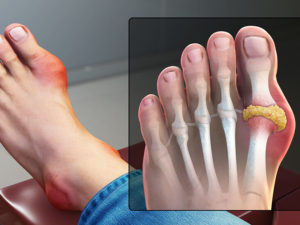 I am experiencing pain and swelling in my big toe; could it be gout? Flares of gout hit the base of the big toe that is common with gout. Gout symptoms may start with some swelling and tingling sensation. It quickly turns to extremely painful, red, and swollen; the pain is intolerable. Patients should seek gout treatment immediately, but they ignore the pain until they cannot walk or put on shoes. Some even mistakenly think it is a toe injury that will go away.
I am experiencing pain and swelling in my big toe; could it be gout? Flares of gout hit the base of the big toe that is common with gout. Gout symptoms may start with some swelling and tingling sensation. It quickly turns to extremely painful, red, and swollen; the pain is intolerable. Patients should seek gout treatment immediately, but they ignore the pain until they cannot walk or put on shoes. Some even mistakenly think it is a toe injury that will go away.
Gout attacks are sudden without prior warning signs; it happens in the middle of the night. The first episode can last a few days or even weeks. Some patients have frequent flares, while others take even a year before it happens again. Gout is intense pain and inflammation in the joints and soft tissue because of the excess build-up of uric acid crystals.
Symptoms in the big toe
The pain experienced is severe, and the symptoms get worse within 12 hours. Immediate gout pain relief of the big toe joint can take place within one or two weeks.
- Intense burning or throbbing joint pain followed by redness, swelling, discoloration, and feels warm to the touch.
- Rapid onset of symptoms
- Discoloration or redness and swelling
- Difficulties in moving and even standing
- Tenderness
- Shiny skin over the affected joint
When to consult a podiatrist?
If you experience any of the symptoms and have not been diagnosed previously with gout, book an appointment. If you run a high fever and the pain gets worse, seek gout in foot treatment. It is vital to get confirmation because other conditions cause toe joint pain, such as an infected toe that could exhibit the same symptoms.
If you have gout and you have an attack or a flare, consult about the prescribed medication you are taking.
If you have questions about caring for gout in your foot, you should reach out to a foot specialist for his/her expert advice. Feel free to contact our office to make an appointment with our podiatrist. Our foot and ankle doctor, Dr. Ejodamen Shobowale, can provide you with the care you need to keep you pain-free on your feet.
Causes of Gout
Gout is an effect of a build-up of uric acid in the blood, but how does the build-up happen?
The kidneys may be ineffective in getting rid of excess uric acid is produced by the body, it causes tiny sharp crystals to form around the joints. The build-up around the joints causes it to be painful and inflamed.
There are a few things that can increase the causes of uric acid build-up
- Kidney problems.
- Underlying conditions such as high blood pressure, diabetes, and obesity.
- Intake of foods with high uric acid build-ups, such as seafood, red meat, and offal.
- Taking too many spirits or beer.
Gout in Foot Treatment
Just remember that you need to call a podiatrist immediately you experience a flare but, in the meantime,
- Take nonsteroidal anti-inflammatory drugs such as ibuprofen, naproxen, and celecoxib. Do not take aspirin because it may make the flare worse.
- Apply an ice pack and elevate the foot to ease pain and inflammation. The foot should be elevated higher than the chest and apply the ice pack several times a day.
- Take 8 to 16 cups of fluid and water. Avoid sugary drinks and alcohol.
- Use mobility aids such as a cane to relieve pressure on the toe.
- Cut the big toe out of your socks so that no pressure is on the toe.
- Wear open-toe shoes such as sandals.
In the long term
- Ensure that you take regular exercises.
- Maintain moderate weight.
- Avoid foods that may cause gout flares.
Comments
[…] of the classic signs of gout is sharp, sudden pain in the big toe joint that occurs when you least expect it — sometimes even […]